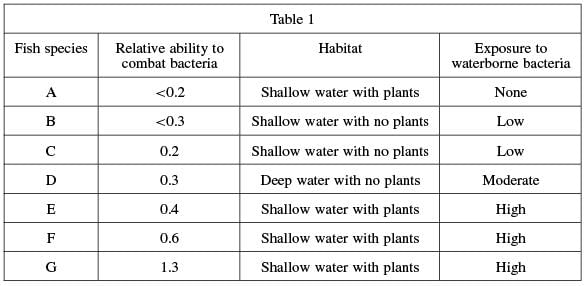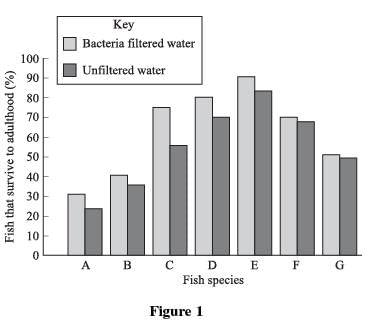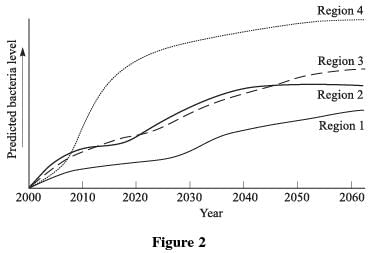ACT Exam > ACT Questions > Directions:Read the passages and choose the b...
Start Learning for Free
Directions: Read the passages and choose the best answer to each question.
Passage
Because fish live in water they are exposed to any bacteria that exist in the water. Table 1 lists the habitat choices of 7 species of fish in a local pond and the fish’s ability to combat the effects of the bacteria found in the water.

Figure 1 shows the percent of fish that survive to adulthood in the lab for the 7 species, after exposure to water with bacteria present or exposure to water with the bacteria removed.

Figure 2 shows predicted bacteria levels over time in 4 geographic regions with fish populations.

Because fish live in water they are exposed to any bacteria that exist in the water. Table 1 lists the habitat choices of 7 species of fish in a local pond and the fish’s ability to combat the effects of the bacteria found in the water.

Figure 1 shows the percent of fish that survive to adulthood in the lab for the 7 species, after exposure to water with bacteria present or exposure to water with the bacteria removed.

Figure 2 shows predicted bacteria levels over time in 4 geographic regions with fish populations.

Q. Based on the information in Figure 1, fish from which species are most likely to survive prolonged exposure to bacteria?
- a)Species A
- b)Species B
- c)Species D
- d)Species E
Correct answer is option 'D'. Can you explain this answer?
Most Upvoted Answer
Directions:Read the passages and choose the best answer to each questi...
Figure 1 shows the percent of fish that survive after exposure to water with bacteria present. The fish species with the highest percent (85%) of fish that survived after prolonged exposure to bacteria (light gray bar) was fish species E. Answer choice D is correct.

|
Explore Courses for ACT exam
|

|
Similar ACT Doubts
Directions:Read the passages and choose the best answer to each question.PassageBecause fish live in water they are exposed to any bacteria that exist in the water. Table 1 lists the habitat choices of 7 species of fish in a local pond and the fish’s ability to combat the effects of the bacteria found in the water.Figure 1 shows the percent of fish that survive to adulthood in the lab for the 7 species, after exposure to water with bacteria present or exposure to water with the bacteria removed.Figure 2 shows predicted bacteria levels over time in 4 geographic regions with fish populations.Q.Based on the information in Figure 1, fish from which species are most likely to survive prolonged exposure to bacteria?a)Species Ab)Species Bc)Species Dd)Species ECorrect answer is option 'D'. Can you explain this answer?
Question Description
Directions:Read the passages and choose the best answer to each question.PassageBecause fish live in water they are exposed to any bacteria that exist in the water. Table 1 lists the habitat choices of 7 species of fish in a local pond and the fish’s ability to combat the effects of the bacteria found in the water.Figure 1 shows the percent of fish that survive to adulthood in the lab for the 7 species, after exposure to water with bacteria present or exposure to water with the bacteria removed.Figure 2 shows predicted bacteria levels over time in 4 geographic regions with fish populations.Q.Based on the information in Figure 1, fish from which species are most likely to survive prolonged exposure to bacteria?a)Species Ab)Species Bc)Species Dd)Species ECorrect answer is option 'D'. Can you explain this answer? for ACT 2025 is part of ACT preparation. The Question and answers have been prepared according to the ACT exam syllabus. Information about Directions:Read the passages and choose the best answer to each question.PassageBecause fish live in water they are exposed to any bacteria that exist in the water. Table 1 lists the habitat choices of 7 species of fish in a local pond and the fish’s ability to combat the effects of the bacteria found in the water.Figure 1 shows the percent of fish that survive to adulthood in the lab for the 7 species, after exposure to water with bacteria present or exposure to water with the bacteria removed.Figure 2 shows predicted bacteria levels over time in 4 geographic regions with fish populations.Q.Based on the information in Figure 1, fish from which species are most likely to survive prolonged exposure to bacteria?a)Species Ab)Species Bc)Species Dd)Species ECorrect answer is option 'D'. Can you explain this answer? covers all topics & solutions for ACT 2025 Exam. Find important definitions, questions, meanings, examples, exercises and tests below for Directions:Read the passages and choose the best answer to each question.PassageBecause fish live in water they are exposed to any bacteria that exist in the water. Table 1 lists the habitat choices of 7 species of fish in a local pond and the fish’s ability to combat the effects of the bacteria found in the water.Figure 1 shows the percent of fish that survive to adulthood in the lab for the 7 species, after exposure to water with bacteria present or exposure to water with the bacteria removed.Figure 2 shows predicted bacteria levels over time in 4 geographic regions with fish populations.Q.Based on the information in Figure 1, fish from which species are most likely to survive prolonged exposure to bacteria?a)Species Ab)Species Bc)Species Dd)Species ECorrect answer is option 'D'. Can you explain this answer?.
Directions:Read the passages and choose the best answer to each question.PassageBecause fish live in water they are exposed to any bacteria that exist in the water. Table 1 lists the habitat choices of 7 species of fish in a local pond and the fish’s ability to combat the effects of the bacteria found in the water.Figure 1 shows the percent of fish that survive to adulthood in the lab for the 7 species, after exposure to water with bacteria present or exposure to water with the bacteria removed.Figure 2 shows predicted bacteria levels over time in 4 geographic regions with fish populations.Q.Based on the information in Figure 1, fish from which species are most likely to survive prolonged exposure to bacteria?a)Species Ab)Species Bc)Species Dd)Species ECorrect answer is option 'D'. Can you explain this answer? for ACT 2025 is part of ACT preparation. The Question and answers have been prepared according to the ACT exam syllabus. Information about Directions:Read the passages and choose the best answer to each question.PassageBecause fish live in water they are exposed to any bacteria that exist in the water. Table 1 lists the habitat choices of 7 species of fish in a local pond and the fish’s ability to combat the effects of the bacteria found in the water.Figure 1 shows the percent of fish that survive to adulthood in the lab for the 7 species, after exposure to water with bacteria present or exposure to water with the bacteria removed.Figure 2 shows predicted bacteria levels over time in 4 geographic regions with fish populations.Q.Based on the information in Figure 1, fish from which species are most likely to survive prolonged exposure to bacteria?a)Species Ab)Species Bc)Species Dd)Species ECorrect answer is option 'D'. Can you explain this answer? covers all topics & solutions for ACT 2025 Exam. Find important definitions, questions, meanings, examples, exercises and tests below for Directions:Read the passages and choose the best answer to each question.PassageBecause fish live in water they are exposed to any bacteria that exist in the water. Table 1 lists the habitat choices of 7 species of fish in a local pond and the fish’s ability to combat the effects of the bacteria found in the water.Figure 1 shows the percent of fish that survive to adulthood in the lab for the 7 species, after exposure to water with bacteria present or exposure to water with the bacteria removed.Figure 2 shows predicted bacteria levels over time in 4 geographic regions with fish populations.Q.Based on the information in Figure 1, fish from which species are most likely to survive prolonged exposure to bacteria?a)Species Ab)Species Bc)Species Dd)Species ECorrect answer is option 'D'. Can you explain this answer?.
Solutions for Directions:Read the passages and choose the best answer to each question.PassageBecause fish live in water they are exposed to any bacteria that exist in the water. Table 1 lists the habitat choices of 7 species of fish in a local pond and the fish’s ability to combat the effects of the bacteria found in the water.Figure 1 shows the percent of fish that survive to adulthood in the lab for the 7 species, after exposure to water with bacteria present or exposure to water with the bacteria removed.Figure 2 shows predicted bacteria levels over time in 4 geographic regions with fish populations.Q.Based on the information in Figure 1, fish from which species are most likely to survive prolonged exposure to bacteria?a)Species Ab)Species Bc)Species Dd)Species ECorrect answer is option 'D'. Can you explain this answer? in English & in Hindi are available as part of our courses for ACT.
Download more important topics, notes, lectures and mock test series for ACT Exam by signing up for free.
Here you can find the meaning of Directions:Read the passages and choose the best answer to each question.PassageBecause fish live in water they are exposed to any bacteria that exist in the water. Table 1 lists the habitat choices of 7 species of fish in a local pond and the fish’s ability to combat the effects of the bacteria found in the water.Figure 1 shows the percent of fish that survive to adulthood in the lab for the 7 species, after exposure to water with bacteria present or exposure to water with the bacteria removed.Figure 2 shows predicted bacteria levels over time in 4 geographic regions with fish populations.Q.Based on the information in Figure 1, fish from which species are most likely to survive prolonged exposure to bacteria?a)Species Ab)Species Bc)Species Dd)Species ECorrect answer is option 'D'. Can you explain this answer? defined & explained in the simplest way possible. Besides giving the explanation of
Directions:Read the passages and choose the best answer to each question.PassageBecause fish live in water they are exposed to any bacteria that exist in the water. Table 1 lists the habitat choices of 7 species of fish in a local pond and the fish’s ability to combat the effects of the bacteria found in the water.Figure 1 shows the percent of fish that survive to adulthood in the lab for the 7 species, after exposure to water with bacteria present or exposure to water with the bacteria removed.Figure 2 shows predicted bacteria levels over time in 4 geographic regions with fish populations.Q.Based on the information in Figure 1, fish from which species are most likely to survive prolonged exposure to bacteria?a)Species Ab)Species Bc)Species Dd)Species ECorrect answer is option 'D'. Can you explain this answer?, a detailed solution for Directions:Read the passages and choose the best answer to each question.PassageBecause fish live in water they are exposed to any bacteria that exist in the water. Table 1 lists the habitat choices of 7 species of fish in a local pond and the fish’s ability to combat the effects of the bacteria found in the water.Figure 1 shows the percent of fish that survive to adulthood in the lab for the 7 species, after exposure to water with bacteria present or exposure to water with the bacteria removed.Figure 2 shows predicted bacteria levels over time in 4 geographic regions with fish populations.Q.Based on the information in Figure 1, fish from which species are most likely to survive prolonged exposure to bacteria?a)Species Ab)Species Bc)Species Dd)Species ECorrect answer is option 'D'. Can you explain this answer? has been provided alongside types of Directions:Read the passages and choose the best answer to each question.PassageBecause fish live in water they are exposed to any bacteria that exist in the water. Table 1 lists the habitat choices of 7 species of fish in a local pond and the fish’s ability to combat the effects of the bacteria found in the water.Figure 1 shows the percent of fish that survive to adulthood in the lab for the 7 species, after exposure to water with bacteria present or exposure to water with the bacteria removed.Figure 2 shows predicted bacteria levels over time in 4 geographic regions with fish populations.Q.Based on the information in Figure 1, fish from which species are most likely to survive prolonged exposure to bacteria?a)Species Ab)Species Bc)Species Dd)Species ECorrect answer is option 'D'. Can you explain this answer? theory, EduRev gives you an
ample number of questions to practice Directions:Read the passages and choose the best answer to each question.PassageBecause fish live in water they are exposed to any bacteria that exist in the water. Table 1 lists the habitat choices of 7 species of fish in a local pond and the fish’s ability to combat the effects of the bacteria found in the water.Figure 1 shows the percent of fish that survive to adulthood in the lab for the 7 species, after exposure to water with bacteria present or exposure to water with the bacteria removed.Figure 2 shows predicted bacteria levels over time in 4 geographic regions with fish populations.Q.Based on the information in Figure 1, fish from which species are most likely to survive prolonged exposure to bacteria?a)Species Ab)Species Bc)Species Dd)Species ECorrect answer is option 'D'. Can you explain this answer? tests, examples and also practice ACT tests.

|
Explore Courses for ACT exam
|

|
Signup for Free!
Signup to see your scores go up within 7 days! Learn & Practice with 1000+ FREE Notes, Videos & Tests.


























